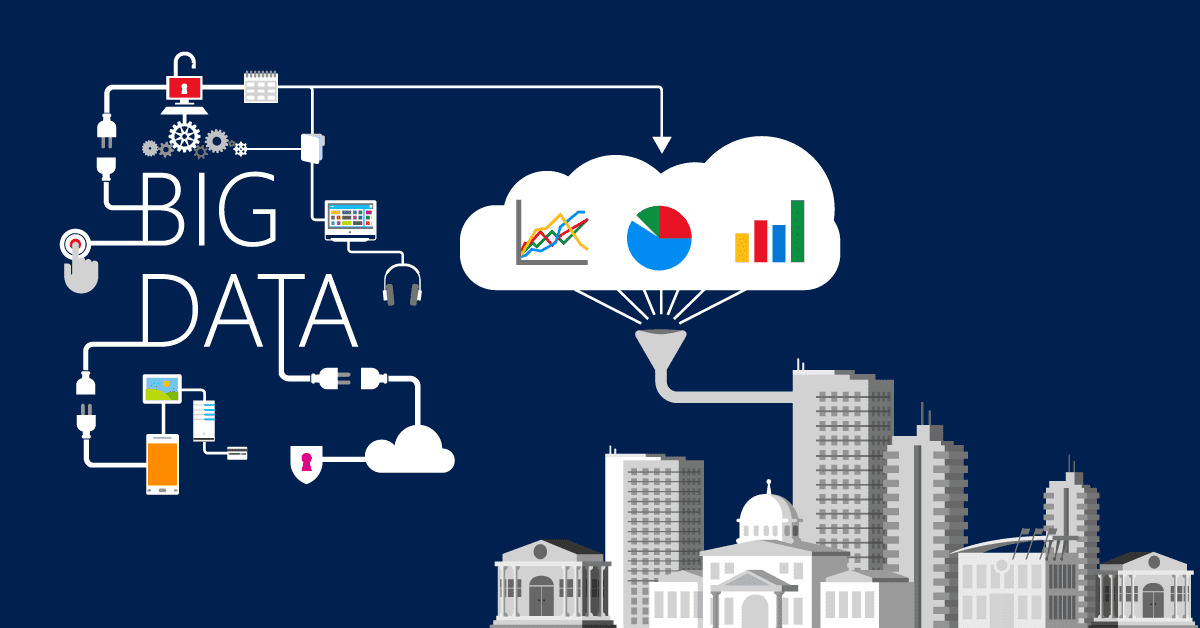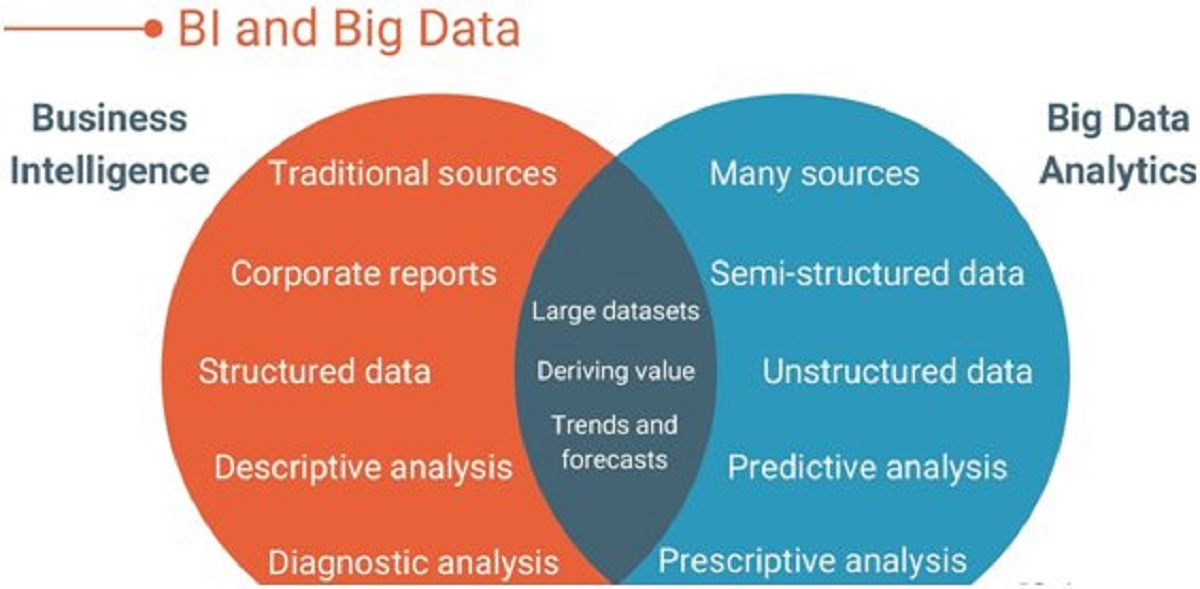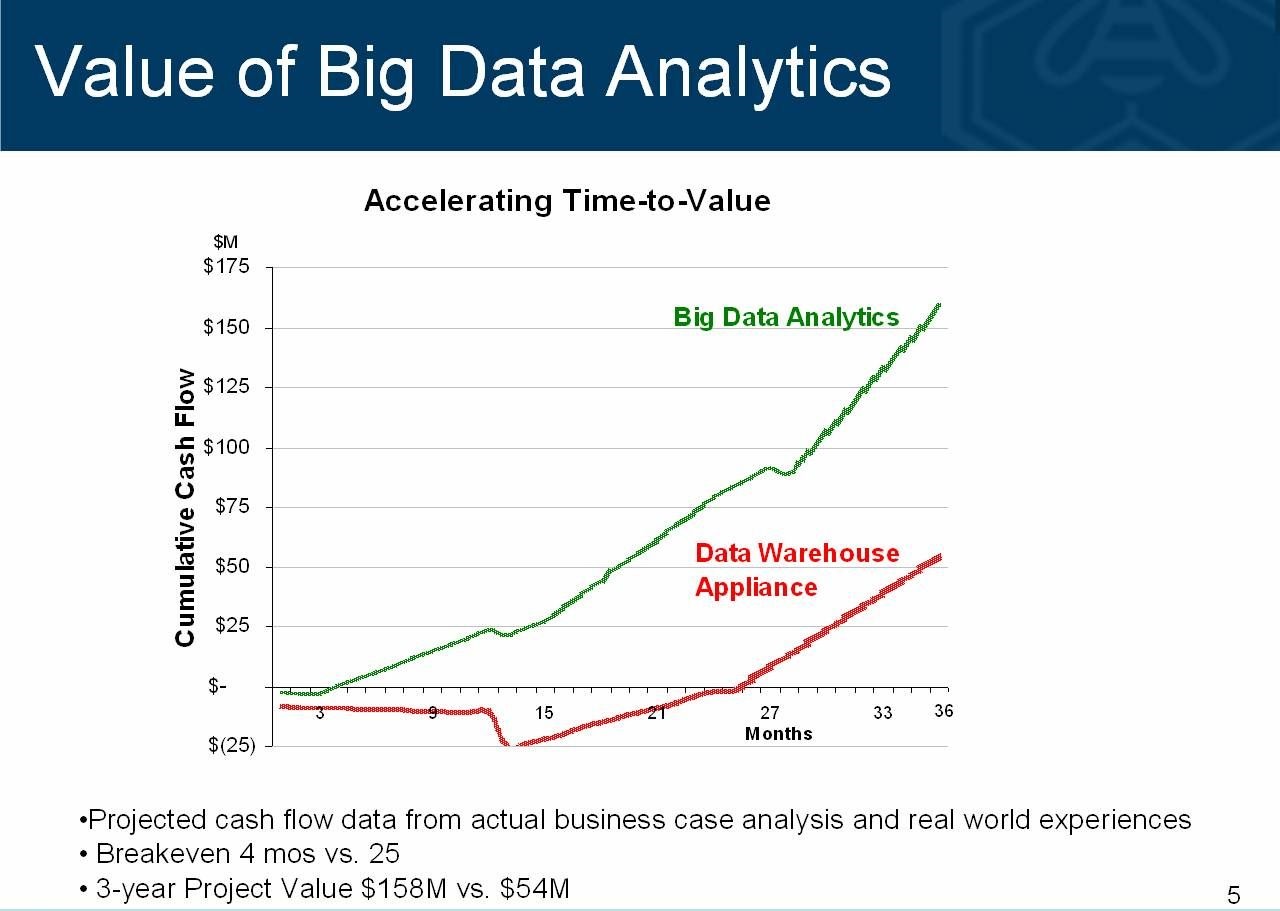Introduction
Welcome to the world of big data analytics! In today’s digital age, organizations across various industries are grappling with an exponential increase in data. This deluge of information has the potential to provide invaluable insights and drive business success, but only if effectively analyzed and harnessed. That’s where big data analytics comes in.
Big data analytics is the process of extracting, transforming, and analyzing large and complex datasets to uncover patterns, trends, and associations that can help organizations make data-driven decisions. It involves the use of advanced technologies, algorithms, and statistical models to derive meaningful insights from vast amounts of structured and unstructured data.
The benefits of implementing big data analytics are far-reaching. It enables organizations to gain a competitive edge by leveraging data-driven insights to optimize operations, enhance customer experiences, and identify new revenue streams. With the ability to crunch massive volumes of data in real-time or near-real-time, big data analytics empowers businesses to make faster and more accurate decisions.
In this article, we will delve into the intricacies of implementing big data analytics, from setting up the required infrastructure to data collection, processing, analysis, and visualization. We will also explore the various tools and technologies available to facilitate the analytics process and touch on the challenges and considerations organizations need to be aware of.
So, if you’re ready to harness the power of big data analytics and unlock its full potential, let’s dive in and explore the world of data-driven insights!
What is Big Data Analytics?
Big data analytics is a field of analysis that deals with extracting valuable insights from large and complex datasets. It involves employing a combination of advanced techniques, algorithms, and tools to uncover patterns, trends, and correlations within the data. The goal of big data analytics is to obtain meaningful and actionable information that can drive informed decision-making and help organizations achieve their objectives.
The term “big data” refers to datasets that are massive in size, typically characterized by the three Vs: volume, velocity, and variety. Volume refers to the sheer amount of data being generated, which can range from terabytes to petabytes or even exabytes. Velocity refers to the speed at which data is generated, often requiring real-time or near-real-time analysis. Variety refers to the diverse types of data, including structured, semi-structured, and unstructured data from various sources like social media, sensors, logs, and more.
Big data analytics goes beyond traditional analytics methods, such as business intelligence or statistical analysis, because it is specifically designed to handle the challenges posed by big data. It combines techniques from various fields, including machine learning, data mining, data visualization, and natural language processing, to uncover insights from the massive volumes of data.
The process of big data analytics typically involves several stages. First, data is collected from various sources, such as databases, sensors, social media platforms, and more. After collection, the data is stored in a data lake or a distributed file system that can handle the large volume and variety of data. Then, the data is processed and prepped for analysis, which may involve cleaning, transforming, and structuring the data.
Next, comes the analysis phase, where various statistical, machine learning, or predictive modeling algorithms are applied to the data to extract insights. This can include identifying trends, making predictions, detecting anomalies, or uncovering hidden patterns within the data. The results of the analysis are then visualized and presented in a meaningful and understandable format, often using charts, graphs, or dashboards.
Overall, big data analytics enables organizations to gain a deeper understanding of their data, customers, and business operations. It provides the ability to make data-driven decisions that are based on solid evidence and insights derived from the analysis of large and complex datasets.
Benefits of Implementing Big Data Analytics
Implementing big data analytics offers numerous advantages for organizations across various industries. These benefits stem from the ability to extract valuable insights from large volumes of data, enabling data-driven decision-making and improved business outcomes. Here are some key benefits of implementing big data analytics:
- Data-driven decision-making: Big data analytics enables organizations to make informed decisions based on data and evidence rather than relying solely on intuition or gut feelings. By analyzing large and diverse datasets, businesses can uncover patterns, trends, and correlations that can guide strategic planning, product development, and process optimization.
- Improved customer experiences: Big data analytics allows organizations to gain a deeper understanding of their customers by analyzing their behavior, preferences, and feedback. This knowledge enables businesses to personalize marketing campaigns, create targeted offers, and enhance customer experiences, leading to increased customer satisfaction and loyalty.
- Enhanced operational efficiency: By analyzing operational data, organizations can identify bottlenecks, inefficiencies, and areas for improvement in their processes. This insight enables businesses to streamline operations, optimize resource allocation, and reduce costs, ultimately improving operational efficiency and productivity.
- Identification of new revenue streams: Big data analytics can uncover untapped market opportunities or emerging trends by analyzing large datasets. This insight allows organizations to identify new revenue streams, develop innovative products or services, and stay ahead of the competition in a rapidly changing business landscape.
- Proactive risk management: By analyzing historical and real-time data, organizations can detect potential risks or anomalies and take proactive measures to mitigate them. This can range from fraud detection in financial institutions to predicting equipment failures in manufacturing, enabling businesses to avoid costly disruptions and minimize risks.
- Improved strategic planning: Big data analytics provides organizations with a holistic view of their business, industry, and market trends. This insight allows businesses to make informed strategic decisions, identify emerging opportunities, and adapt their strategies to stay competitive in a dynamic business environment.
These benefits highlight the value of implementing big data analytics in today’s data-driven world. By leveraging large and diverse datasets, organizations can gain a competitive edge, drive innovation, improve operational efficiency, and deliver enhanced customer experiences.
Setting Up a Big Data Infrastructure
Setting up a robust and scalable infrastructure is an essential first step in implementing big data analytics. The infrastructure serves as the foundation for storing, processing, and analyzing large volumes of data. Here are key considerations when setting up a big data infrastructure:
- Data Storage: To handle the vast amount of data, organizations need a storage solution that is capable of storing structured, semi-structured, and unstructured data. Options include distributed file systems like Apache Hadoop HDFS or cloud-based storage services like Amazon S3. Choosing the right storage solution depends on factors such as data volume, accessibility requirements, and cost considerations.
- Data Processing: Big data analytics requires distributed processing frameworks that can handle the parallel processing of large datasets. Apache Hadoop, with its MapReduce framework, is a popular choice for batch processing. Additionally, technologies like Apache Spark provide fast in-memory processing capabilities for real-time or near-real-time analytics.
- Scalability: A big data infrastructure needs to be scalable to accommodate the increasing volume of data and analytic workloads. This can be achieved through horizontal scalability by adding more servers or nodes to the infrastructure, or through cloud-based solutions that offer elastic scalability.
- Data Integration: Integrating data from disparate sources is crucial for comprehensive analytics. Extract, Transform, Load (ETL) processes or data integration tools can be used to combine and prepare data for analysis. These processes involve cleansing, transforming, and structuring the data to ensure accuracy and consistency.
- Data Governance: Establishing proper data governance ensures that data is managed securely, ethically, and in compliance with regulations. This includes defining data ownership, access controls, data quality standards, and data privacy policies to protect sensitive information.
- Infrastructure Management: Big data infrastructure requires efficient management and monitoring to ensure optimal performance. This involves regular maintenance, capacity planning, resource allocation, and monitoring of system health and performance to identify any bottlenecks or issues.
Organizations can choose to build their own on-premises infrastructure or opt for cloud-based solutions offered by providers such as Amazon Web Services (AWS), Google Cloud Platform, or Microsoft Azure. Cloud-based solutions offer the advantage of scalability, flexibility, and reduced maintenance overhead.
Overall, setting up a big data infrastructure requires careful planning and consideration of various factors such as data storage, processing, scalability, integration, governance, and infrastructure management. Investing in a solid infrastructure is crucial to ensure the success and effectiveness of big data analytics initiatives.
Collecting and Storing Data
Collecting and storing data is a vital step in the big data analytics process. It involves gathering data from various sources, organizing it, and ensuring its accessibility for analysis. Here are key considerations when collecting and storing data for big data analytics:
- Data Sources: Identify the sources of data that are relevant to your organization and analytics goals. This can include structured data from databases, transactional systems, or spreadsheets, as well as unstructured data from social media platforms, sensors, and customer feedback.
- Data Collection: Implement mechanisms to collect data from various sources. This can be done through automated data feeds, APIs, web scraping, or manual data entry. It is crucial to ensure the accuracy, consistency, and quality of collected data.
- Data Integration: Integrate data from disparate sources into a unified format for analysis. This often involves data transformation and cleansing processes to standardize data, resolve inconsistencies, and handle missing values.
- Data Storage: Determine the most suitable storage solution based on the volume and type of data being collected. This can range from traditional relational databases to distributed file systems like Apache Hadoop HDFS or cloud-based storage services.
- Data Security: Establish proper security measures to protect sensitive data throughout the collection and storage process. This includes encryption, access controls, and compliance with data privacy regulations to safeguard personal or confidential information.
- Data Retention: Define retention policies to determine how long data should be stored based on legal requirements, business needs, and the value of the data for future analysis or reference.
- Data Accessibility: Ensure that collected data is easily accessible for analysis. This can involve creating data catalogs, implementing data discovery tools, or providing self-service analytics capabilities to enable users to explore and retrieve data as needed.
When collecting and storing data for big data analytics, it is essential to consider scalability, as the volume of data may grow significantly over time. This is where distributed file systems or cloud-based storage solutions offer advantages, allowing organizations to scale their storage infrastructure as needed.
Implementing proper data governance practices is also critical. This includes defining data ownership, data quality standards, metadata management, and data lineage to ensure the reliability, accuracy, and consistency of the collected data.
In summary, collecting and storing data for big data analytics requires careful planning, integration of diverse data sources, implementation of robust security measures, and adoption of scalable storage solutions. By establishing a solid foundation for data collection and storage, organizations can lay the groundwork for effective and successful big data analytics initiatives.
Data Processing and Analysis
Data processing and analysis are critical stages in the big data analytics journey. After collecting and storing data, organizations need to process and analyze it to derive meaningful insights. Here’s an overview of the key aspects of data processing and analysis:
- Data Cleansing and Preparation: Before analysis can take place, it is essential to clean and prepare the data. This involves removing duplicate records, handling missing values, resolving inconsistencies, and formatting the data into a usable format. Data cleansing ensures the accuracy and quality of the data used for analysis.
- Data Transformation: Data transformation involves converting and standardizing the data into a common format that is suitable for analysis. This may include aggregating data, performing calculations, or applying algorithms to derive new variables or metrics.
- Data Modeling: Data modeling involves applying statistical, machine learning, or predictive modeling techniques to uncover patterns, relationships, and trends within the data. This can include clustering, classification, regression, or time series analysis, depending on the specific objectives of the analysis.
- Exploratory Data Analysis (EDA): EDA involves visualizing and exploring the data to gain insights and identify potential patterns or outliers. This can be done through various data visualization techniques such as charts, graphs, or interactive dashboards, enabling analysts to thoroughly understand the data and identify any anomalies or trends.
- Hypothesis Testing: Hypothesis testing is used to validate or refute assumptions or hypotheses based on statistical analysis. It provides a way to determine the significance of relationships or differences found within the data and make data-driven decisions based on evidence.
- Predictive Analytics: Predictive analytics involves using historical data and statistical modeling techniques to make predictions or forecasts about future outcomes. This can be valuable in various domains, such as sales forecasting, demand planning, or fraud detection.
- Real-time Analytics: Real-time analytics enables organizations to process and analyze data as it is generated, allowing for immediate insights and actions. This can be useful in industries such as finance, IoT, or cybersecurity, where prompt decision-making is critical.
Data processing and analysis can be performed using a combination of programming languages (such as Python or R), data processing frameworks (like Apache Spark), and analytics tools (such as Tableau or SAS). These tools provide the capabilities to manage and analyze large volumes of data efficiently and effectively.
It’s important to note that data processing and analysis are iterative processes. Analysts may iterate through the steps multiple times, refining their approach, and experimenting with different algorithms or techniques to gain deeper insights or improve the accuracy of predictions.
The ultimate goal of data processing and analysis is to extract actionable insights that drive informed decision-making, optimize processes, and unlock new opportunities for business growth.
Choosing the Right Big Data Analytics Tools
Choosing the right big data analytics tools is crucial for organizations looking to effectively analyze large and complex datasets. With a wide range of tools and technologies available in the market, it’s important to consider various factors when making a selection. Here are key considerations when choosing big data analytics tools:
- Data Scale and Variety: Assess the scalability and flexibility of the tools to handle the volume, velocity, and variety of your data. Ensure that the tools can accommodate both structured and unstructured data and have the capacity to scale as your data grows.
- Analysis Capabilities: Evaluate the analysis capabilities of the tools. Consider whether they offer the necessary statistical, machine learning, or predictive modeling algorithms required to address your specific analytical needs.
- Data Integration: Look for tools that have strong data integration capabilities, allowing you to easily connect and integrate various data sources. This ensures that you can access and analyze all relevant data in a unified manner.
- Data Visualization: Consider the data visualization capabilities of the tools. Effective data visualization aids in interpreting and communicating insights gained from the analysis. Look for tools that provide interactive and intuitive visualization features.
- Scalability and Performance: Evaluate the performance and scalability features of the tools. Consider factors such as processing speed, memory management, and the ability to handle parallel processing or distributed computing to ensure efficient and timely analysis.
- User-Friendliness: Assess the ease of use and user-friendliness of the tools. Look for intuitive interfaces, drag-and-drop functionality, or user-friendly programming languages that enable analysts of varying skill levels to work efficiently.
- Integration with Existing Systems: Consider the compatibility of the tools with your existing data infrastructure and systems. Look for tools that can seamlessly integrate with your current technology stack to avoid disruptions and maximize efficiency.
- Cost Considerations: Evaluate the cost structure of the tools. Consider factors such as licensing fees, maintenance costs, and potential training expenses. Look for tools that align with your budgetary constraints while still meeting your analytical requirements.
- Community Support: Consider the availability of a vibrant user community and active developer support for the tools you are considering. This ensures access to resources, documentation, tutorials, and forums that can assist in troubleshooting and further skill development.
Popular big data analytics tools include Apache Hadoop, Apache Spark, Python libraries like pandas and scikit-learn, and commercial tools like Tableau, SAS, or IBM Watson Analytics. It’s important to evaluate and compare different tools based on your organization’s specific needs and priorities.
Keep in mind that the selection of tools may evolve over time as your organization’s requirements change or as new tools and technologies emerge in the fast-evolving big data analytics landscape. Regular evaluation and assessment of your toolset will help ensure that you have the most effective and up-to-date tools for your big data analytics initiatives.
Building Models and Algorithms
Building models and algorithms is a critical step in the big data analytics process, enabling organizations to extract meaningful insights and make accurate predictions. This stage involves applying statistical and machine learning techniques to analyze data and create models that can uncover patterns, relationships, and trends. Here are key considerations when building models and algorithms:
- Business Understanding: Clearly define the business problem or objective that the model or algorithm aims to address. Understand the specific requirements, desired outcomes, and key performance indicators (KPIs) that will measure success.
- Data Exploration: Conduct thorough data exploration to gain insights into the characteristics and distribution of the data. This involves examining data statistics, visualizing data distributions, and identifying potential outliers or missing values that may require further attention.
- Feature Engineering: Transform raw data into meaningful features that best represent the problem at hand. This may involve selecting relevant variables, creating new derived features, and normalizing or scaling the data to ensure consistency and improve model performance.
- Model Selection: Choose the appropriate model or algorithm that best suits the problem you are trying to solve. Consider factors such as the nature of the data, the type of analysis required (classification, regression, clustering, etc.), and the assumptions or constraints associated with different models.
- Model Training: Train the selected model using the available data. This involves feeding the data into the model, adjusting model parameters, and evaluating its performance. Techniques such as cross-validation can help assess the model’s ability to generalize well to unseen data.
- Model Evaluation: Assess the performance of the trained model using appropriate evaluation metrics. Consider metrics such as accuracy, precision, recall, F1-score, or mean squared error, depending on the nature of the problem. Compare the model’s performance against baseline or industry benchmarks.
- Model Optimization: Fine-tune the model and its parameters to improve performance. Techniques such as regularization, hyperparameter tuning, or ensemble methods can be employed to enhance the model’s ability to generalize and make accurate predictions.
- Validation and Deployment: Validate the model’s performance on unseen data to ensure its robustness and reliability. Once satisfied with the model’s performance, deploy it into production, integrating it into your business processes or applications to generate real-time predictions or insights.
When building models and algorithms, it is essential to strike a balance between model complexity and interpretability. While complex models may deliver high accuracy, they may be harder to interpret and explain to stakeholders. Simple models, on the other hand, may sacrifice some accuracy but offer a clearer understanding of the underlying relationships.
It’s important to consider the iterative nature of model building and continue refining models as new data becomes available or as business requirements change. Regular model evaluation and optimization help ensure that the models remain relevant and effective over time.
Various programming languages and libraries, such as Python with libraries like scikit-learn, TensorFlow, or R with packages like caret or randomForest, offer a wide range of tools for building models and algorithms. Experimentation, testing, and collaboration with data scientists and domain experts can help create models that deliver the most accurate and valuable insights for your organization.
Visualization and Reporting
Visualization and reporting play a crucial role in big data analytics by transforming complex data into easily understandable and actionable insights. Visualizations help analysts and stakeholders gain a comprehensive view of the data, identify patterns, and communicate findings effectively. Here are key considerations when it comes to visualization and reporting in big data analytics:
- Understanding the Audience: Tailor visualizations and reports to the intended audience. Consider their level of technical expertise, the specific information they are seeking, and their preferred presentation format. Visualizations should be designed to effectively convey insights to both technical and non-technical stakeholders.
- Selecting the Right Visualizations: Choose appropriate visualizations that effectively represent the data and highlight the desired insights. Common types of visualizations include bar charts, line graphs, scatter plots, heatmaps, and geographic maps. Interactive dashboards can also provide dynamic exploration and visualization capabilities.
- Designing Clear and Engaging Visuals: Create visually appealing and intuitive visualizations that are easy to interpret. Use clear labels, appropriate color schemes, and proper scaling to avoid confusion or misinterpretation. Incorporate interactive features that allow users to explore the data and uncover more details.
- Telling a Story: Frame visualizations and reports in a narrative structure that tells a compelling story. Begin with a clear problem statement or insight, present supporting evidence, and conclude with actionable recommendations. Use annotations or captions to provide context and guide the reader’s understanding.
- Ensuring Data Integrity: Verify the accuracy and reliability of the data used in visualizations and reports. Perform data validation checks and address any data quality issues prior to presenting the insights. Transparently communicate any assumptions or limitations associated with the data or analysis.
- Choosing the Right Reporting Tools: Evaluate reporting tools that support the creation of visually appealing reports and dashboards. Consider tools such as Tableau, Power BI, or Google Data Studio, which offer interactive and customizable features for data visualization and reporting. These tools often provide options for scheduling and automated data refreshing.
- Iterative Refinement: Continuously refine and improve visualizations and reports based on feedback and evolving business needs. Regularly reassess the effectiveness of visuals and update them as new insights emerge or as requirements change.
- Collaboration and Communication: Foster collaboration among stakeholders by sharing visualizations and reports through interactive platforms or collaborative tools. Encourage discussions and feedback to ensure a shared understanding of the insights and facilitate data-driven decision-making.
Visualizations and reports help transform complex data into actionable insights that drive decision-making and business outcomes. By effectively communicating findings through visually engaging and informative reports, organizations can empower stakeholders to make informed decisions and take appropriate actions to address challenges or leverage opportunities.
Remember, the ultimate aim of visualization and reporting is to enable stakeholders to grasp the key insights quickly and facilitate data-driven conversations and decisions.
Ensuring Data Security and Privacy
Data security and privacy are paramount considerations when implementing big data analytics. Protecting sensitive data from unauthorized access and ensuring compliance with privacy regulations are crucial for building trust and maintaining the integrity of data-driven initiatives. Here are key aspects to consider when it comes to ensuring data security and privacy:
- Secure Data Infrastructure: Implement strong security measures to protect the infrastructure where data is stored and processed. This includes robust access controls, encryption, and regular security audits to identify and address vulnerabilities.
- Authentication and Authorization: Implement robust authentication mechanisms to ensure that only authorized individuals can access and manipulate the data. Role-based access control and multi-factor authentication systems can help safeguard sensitive information.
- Data Encryption: Encrypt data at rest and in transit to protect it from unauthorized access. Utilize encryption algorithms and techniques to ensure that even if data is compromised, it remains unreadable and unusable to unauthorized parties.
- Data Masking and Anonymization: Mask or anonymize personally identifiable information (PII) to minimize the risk of data breaches. Replace sensitive data with artificial placeholders while preserving the integrity and usefulness of the data for analysis.
- Data Governance and Compliance: Establish data governance policies and procedures to ensure compliance with applicable regulations, such as GDPR or HIPAA. This includes defining data retention periods, monitoring access and usage, and implementing procedures for data subject requests.
- Data Breach Response Plan: Develop a data breach response plan that outlines the steps to be taken in the event of a breach. This includes protocols for notification, containment, investigation, and remediation to minimize impact and protect affected individuals.
- Data Privacy Impact Assessments: Conduct privacy impact assessments to evaluate the potential risks to data privacy and identify measures to mitigate those risks. This ensures privacy considerations are integrated into the design and implementation of big data analytics initiatives.
- Third-Party Data Handling: Ensure that any third-party providers or partners involved in data handling adhere to strict security and privacy standards. Establish data sharing agreements, regularly review their security practices, and monitor compliance.
- Employee Awareness and Training: Educate employees on data security and privacy best practices. Regularly train staff on security protocols, emphasize the importance of protecting data, and foster a culture of data privacy awareness throughout the organization.
- Regular Auditing and Monitoring: Implement systems for auditing and monitoring data access and usage. Regularly review logs and security measures to detect and respond to any potential threats or vulnerabilities proactively.
Ensuring data security and privacy requires a comprehensive and proactive approach. It involves implementing a combination of technical measures, organizational policies, and employee awareness to safeguard data throughout its lifecycle.
Remember, by adopting robust security and privacy practices, organizations can protect sensitive data, mitigate risks, and inspire confidence in data-driven decision-making processes.
Challenges and Considerations in Implementing Big Data Analytics
Implementing big data analytics comes with its own set of challenges and considerations. While the potential benefits are enormous, organizations need to be aware of the following factors to ensure successful implementation:
- Data Quality: Ensuring data quality is crucial for accurate analysis and reliable insights. The sheer volume and variety of big data can present challenges in terms of data accuracy, completeness, consistency, and bias. Implementing proper data cleansing, validation, and quality assurance processes is essential to mitigate these challenges.
- Data Integration: Integrating and harmonizing data from various sources can be complex and time-consuming. Different data formats, structures, and systems may require significant effort to align and consolidate data for analysis. Organizations need to invest in data integration tools and processes to streamline this task.
- Resource Requirements: Implementing big data analytics often demands significant computational power, storage capacity, and skilled personnel. Organizations need to consider the costs associated with infrastructure, software, licenses, training, and ongoing maintenance to ensure the availability of adequate resources.
- Technical Complexity: Big data analytics involves complex technologies, algorithms, and programming languages. Organizations need to have skilled data scientists, analysts, and IT professionals who possess the necessary knowledge and expertise to effectively work with big data tools and frameworks.
- Privacy and Ethical Considerations: Leveraging big data analytics raises concerns around privacy, data protection, and ethics. Organizations must comply with privacy laws and regulations, ensure informed consent for data usage, and employ proper anonymization and data protection techniques to respect individuals’ privacy rights and avoid ethical implications.
- Security Risks: Big data analytics introduces additional security risks due to the large-scale collection, storage, and processing of data. Organizations should implement robust security measures, such as encryption, access controls, and regular audits, to protect data from unauthorized access, breaches, or misuse.
- Overcoming Silos: Siloed data and fragmented systems can hinder the effectiveness of big data analytics initiatives. Organizations need to break down silos and foster a culture of data sharing and collaboration to ensure that relevant data from different departments or business units can be leveraged for comprehensive analysis.
- Scaling and Agility: As data volumes and analytics requirements grow, organizations need to ensure that their infrastructure and processes are scalable and agile. This requires investing in technologies that can handle increasing data loads and adapting analytics approaches to evolving business needs.
- Ethical and Bias Considerations: Big data analytics can inadvertently introduce biases if not carefully managed. Biases can exist in data collection, algorithm development, or interpretation of results. Organizations should be vigilant in addressing biases, conducting fairness assessments, and creating transparency to maintain ethical standards.
- Change Management: Implementing big data analytics involves significant changes in processes, workflows, and organizational culture. Organizations need to invest in change management efforts to ensure smooth adoption and acceptance of big data analytics practices throughout the organization.
By understanding and addressing these challenges and considerations proactively, organizations can navigate the complexities of implementing big data analytics successfully and unlock the full potential of their data-driven initiatives.
Conclusion
Big data analytics offers immense potential for organizations to gain valuable insights, make informed decisions, and drive business success. By effectively implementing big data analytics, organizations can harness the power of vast and complex datasets to optimize operations, enhance customer experiences, and identify new opportunities. However, successful implementation requires careful consideration of various factors.
From setting up a robust infrastructure to collecting, processing, and analyzing data, organizations must navigate challenges such as data quality, integration, resource requirements, and technical complexity. Ensuring data security, privacy, and compliance with regulations is essential to maintain the trust of customers and stakeholders.
Choosing the right tools and algorithms, and effectively visualizing and reporting insights, enables organizations to communicate complex findings clearly and facilitate data-driven decision-making. Education, collaboration, and change management are vital to establishing a data-driven culture and ensuring the adoption and acceptance of big data analytics practices throughout the organization.
As technology continues to evolve, organizations must stay agile and adaptable to embrace emerging trends and advancements in big data analytics. Regular evaluation and optimization of analytics processes, models, and tools are crucial to keep pace with evolving business needs and stay ahead of the competition.
In conclusion, big data analytics has the potential to revolutionize the way organizations operate, make decisions, and drive innovation. By effectively implementing big data analytics, organizations can unlock the power of their data, gain valuable insights, and achieve tangible business outcomes in today’s data-driven world.

























